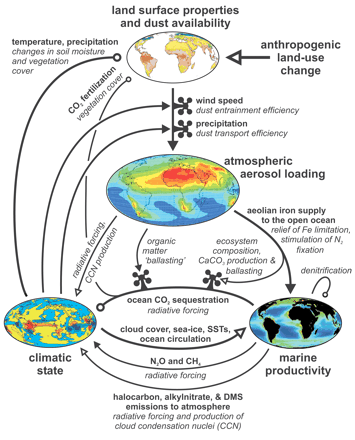
Fig. 1. Schematic view of global iron and dust connections. Highlighted are the four critical components (clockwise from top): the state of the land surface and dust availability, atmospheric aerosol loading, marine productivity, and some measure of climatic state (such as mean global surface temperature). The sign of the connections linking these varies; where the correlation is positive (for example, increased atmospheric aerosol loading→increased marine productivity), the line is terminated with a solid arrowhead. Where the correlation is negative (for example, increased marine productivity→lower CO2 and a colder climate), the termination is an open circle. Connections with an uncertain sign are terminated with an open arrowhead. The mechanism by which the link acts (for example, the impact of a change in atmospheric CO2 is via the radiative forcing of climate) is displayed in italics. Finally, the "water tap" symbols represent a secondary mechanism modulating the effect of a primary mechanism; for instance, a change in global precipitation strength and distribution will alter the efficiency with which entrained dust is transported to the open ocean. If a path of successive connections can be traced from any given component back to itself, a closed or feedback loop is formed. An even number (including zero) of negatively correlated connections counted around the loop gives a positive feedback, which will act to amplify a perturbation and tend to destabilize the system. Conversely, an odd number of negative correlations gives a negative feedback, dampening any perturbation and thus stabilizing the system. For instance, atmospheric aerosol loading→marine productivity→climatic state→dust availability→atmospheric aerosol loading contains two negative and two positive correlations and thus is positive overall. In contrast, marine productivity looping back onto itself contains a single negative correlation and thus represents a negative feedback.
〔Jickells,T.D., An,Z.S., Andersen,K.K., Baker,A.R., Bergametti,G., Brooks,N., Cao,J.J., Boyd,P.W., Duce,R.A., Hunter,K.A., Kawahata,H., Kubilay,N., laRoche,J., Liss,P.S., Mahowald,N., Prospero,J.M., Ridgwell,A.J., Tegen,I. and Torres,R.(2005): Global iron connections between desert dust, ocean biogeochemistry, and climate. Science, 308, 67-71.から〕
